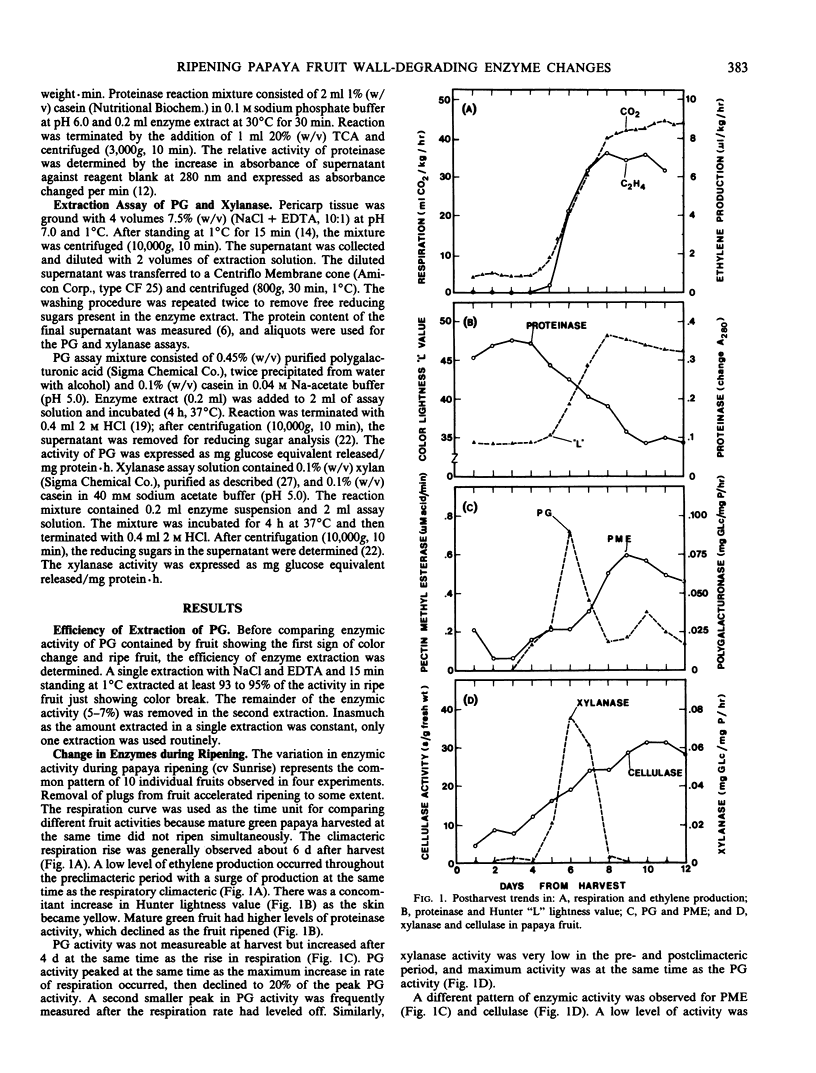Abstract
Pectin methylesterase (PME), polygalacturonase (PG), xylanase, cellulase, and proteinase activity were determined and related to respiration, ethylene evolution, and changes in skin color of papaya (Carica papaya L.) fruit from harvest through to the start of fruit breakdown. PME gradually increased from the start of the climacteric rise reaching a peak 2 days after the respiratory peak. PG and xylanase were not detectable in the preclimacteric stage but increased during the climacteric: during the post climacteric stage, the PG declined to a level one-quarter of peak activity with xylanase activity returning to zero. Cellulase activity gradually increased 3-fold after harvest to peak at the same time as PME, 2 days after the edible stage. Proteinase declined throughout the climacteric and postclimacteric phases. A close relationship exists between PG and xylanase and the rise in respiration, ethylene evolution, and softening. Cultivar differences in postclimacteric levels of enzymic activity were not detected.
An inhibitor of cellulase activity was detected in preclimacteric fruit. The inhibitor was not benzyl isothiocyanate (BITC). BITC did inhibit PG activity, though no inhibitor of PG activity was detected in preclimacteric homogenates when BITC was highest. The results indicate that inhibitors did not play a direct role in controlling wall softening.
Full text
PDF



Selected References
These references are in PubMed. This may not be the complete list of references from this article.
- Ahmed A. E., Labavitch J. M. Cell Wall Metabolism in Ripening Fruit: I. CELL WALL CHANGES IN RIPENING ;BARTLETT' PEARS. Plant Physiol. 1980 May;65(5):1009–1013. doi: 10.1104/pp.65.5.1009. [DOI] [PMC free article] [PubMed] [Google Scholar]
- Almin K. E., Eriksson K. E., Jansson C. Enzymic degradation of polymers. II. Viscometric determination of cellulase activity in absolute terms. Biochim Biophys Acta. 1967 Jul 11;139(2):248–253. doi: 10.1016/0005-2744(67)90029-0. [DOI] [PubMed] [Google Scholar]
- Awad M., Young R. E. Postharvest Variation in Cellulase, Polygalacturonase, and Pectinmethylesterase in Avocado (Persea americana Mill, cv. Fuerte) Fruits in Relation to Respiration and Ethylene Production. Plant Physiol. 1979 Aug;64(2):306–308. doi: 10.1104/pp.64.2.306. [DOI] [PMC free article] [PubMed] [Google Scholar]
- Bradford M. M. A rapid and sensitive method for the quantitation of microgram quantities of protein utilizing the principle of protein-dye binding. Anal Biochem. 1976 May 7;72:248–254. doi: 10.1006/abio.1976.9999. [DOI] [PubMed] [Google Scholar]
- HOBSON G. E. Pectinesterase in normal and abnormal tomato fruit. Biochem J. 1963 Feb;86:358–365. doi: 10.1042/bj0860358. [DOI] [PMC free article] [PubMed] [Google Scholar]
- Hobson G. E. Polygalacturonase in normal and abnormal tomato fruit. Biochem J. 1964 Aug;92(2):324–332. doi: 10.1042/bj0920324. [DOI] [PMC free article] [PubMed] [Google Scholar]
- ISHERWOOD F. A., JERMYN M. A. Changes in the cell wall of the pear during ripening. Biochem J. 1956 Sep;64(1):123–132. doi: 10.1042/bj0640123. [DOI] [PMC free article] [PubMed] [Google Scholar]
- Jones W. W., Kubota H. SOME CHEMICAL AND RESPIRATIONAL CHANGES IN THE PAPAYA FRUIT DURING RIPENING, AND THE EFFECTS OF COLD STORAGE ON THESE CHANGES. Plant Physiol. 1940 Oct;15(4):711–717. doi: 10.1104/pp.15.4.711. [DOI] [PMC free article] [PubMed] [Google Scholar]
- Patil S. S., Tang C. S. Inhibition of ethylene evolution in papaya pulp tissue by benzyl isothiocyanate. Plant Physiol. 1974 Apr;53(4):585–588. doi: 10.1104/pp.53.4.585. [DOI] [PMC free article] [PubMed] [Google Scholar]
- Taiz L., Honigman W. A. Production of cell wall hydrolyzing enzymes by barley aleurone layers in response to gibberellic Acid. Plant Physiol. 1976 Sep;58(3):380–386. doi: 10.1104/pp.58.3.380. [DOI] [PMC free article] [PubMed] [Google Scholar]


